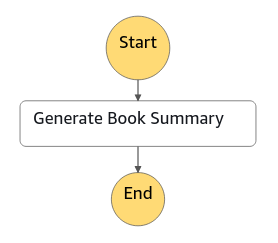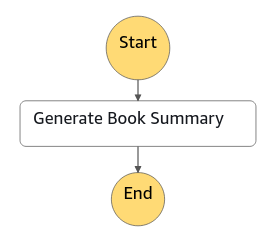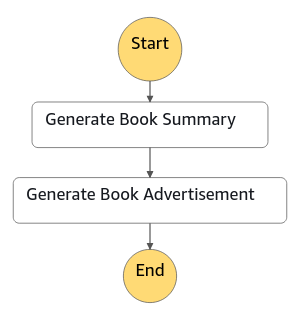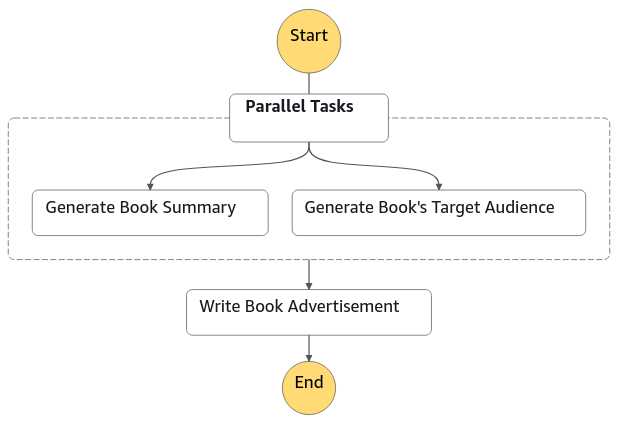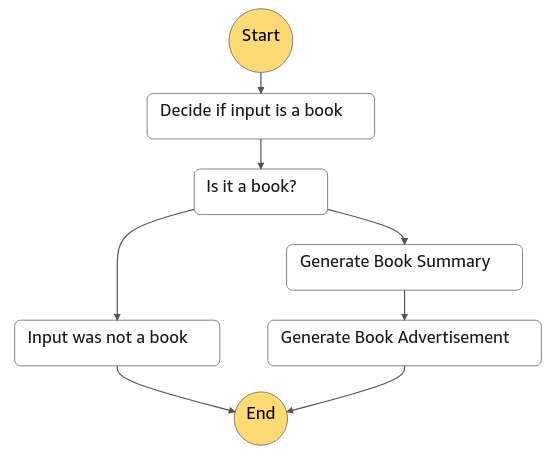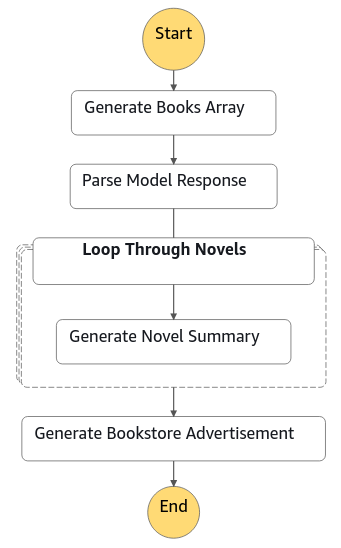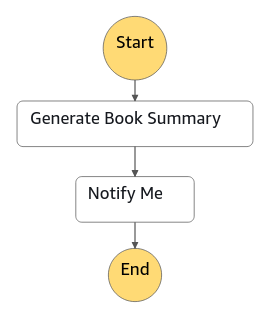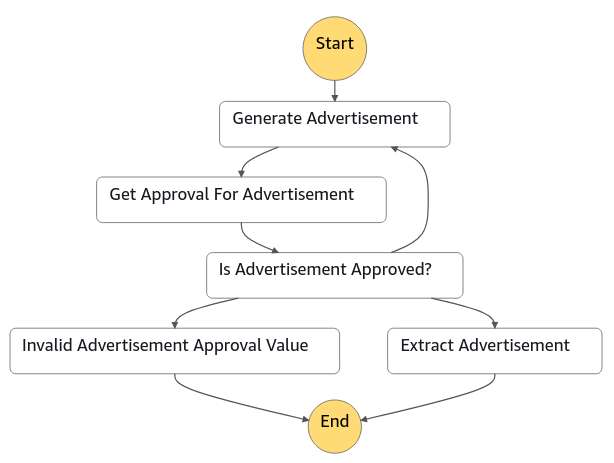This repository provides examples of using AWS Step Functions and Amazon Bedrock to build complex, serverless, and highly scalable generative AI applications with prompt chaining.
Prompt chaining is a technique for building complex generative AI applications and accomplishing complex tasks with large language models (LLMs). With prompt chaining, you construct a set of smaller subtasks as individual prompts. Together, these subtasks make up your overall complex task that you would like the LLM to complete for your application. To accomplish the overall task, your application feeds each subtask prompt to the LLM in a pre-defined order or according to a set of defined rules.
For applications using prompt chaining, Step Functions can orchestrate complex chains of prompts and invoke foundation models in Bedrock. Beyond simple ordered chains of prompts, Step Functions workflows can contain loops, map jobs, parallel jobs, conditions, and input/output manipulation. Workflows can also chain together steps that invoke a foundation model in Bedrock, steps that invoke custom code in AWS Lambda functions, and steps that interact with over 220 AWS services. Both Bedrock and Step Functions are serverless, so you don't have to manage any infrastructure to deploy and scale up your application.
This repository illustrate many prompt chaining techniques that can be orchestrated by Step Functions. The chaining techniques are described below with AWS CDK sample code snippets. The full code can be found in the techniques directory.
Step Functions can invoke models in Bedrock using the
optimized integration for Bedrock.
The body parameter will depend on which model is selected.
from aws_cdk import (
aws_bedrock as bedrock,
aws_stepfunctions as sfn,
aws_stepfunctions_tasks as tasks,
)
# Use the Step Functions integration for Bedrock
tasks.BedrockInvokeModel(
self,
"Generate Book Summary",
# Choose the model to invoke
model=bedrock.FoundationModel.from_foundation_model_id(
self,
"Model",
bedrock.FoundationModelIdentifier.ANTHROPIC_CLAUDE_INSTANT_V1,
),
# Provide the input to the model, including the prompt and inference properties
body=sfn.TaskInput.from_object(
{
"anthropic_version": "bedrock-2023-05-31",
"messages": [
{
"role": "user",
"content": [
{
"type": "text",
# The prompt
"text": "Write a 1-2 sentence summary for the book Pride & Prejudice.",
}
],
}
],
"max_tokens": 250,
"temperature": 1,
}
),
# Extract the response from the model
output_path="$.Body.content[0].text",
)With Step Functions intrinsic functions, prompts be templated. Values such as the execution input or outputs from previous steps can be injected into the prompt.
from aws_cdk import aws_stepfunctions as sfn
# This prompt is templated with the novel name as a variable
# from the Step Functions execution input.
# The input to the Step Functions execution could be:
# "Pride and Prejudice"
"text": sfn.JsonPath.format(
"Write a 1-2 sentence summary for the book {}.",
sfn.JsonPath.string_at("$$.Execution.Input"),
),In a sequential chain, the model response from the first prompt in the chain can be passed as part of the second step's prompt in the chain.
For example, the first prompt might generate a book's summary:
"messages": [
{
"role": "user",
"content": [
{
"type": "text",
# The first prompt
"text": "Write a 1-2 sentence summary for the book Pride & Prejudice.",
}
],
}
],The first prompt can be chained to a second prompt in the Step Functions state machine definition:
chain = generate_book_summary.next(generate_book_advertisement)Then, the second prompt might use that generated book's summary as context for a second task. Step Functions intrinsic functions are used to inject the previous step's output into this step.
"messages": [
{
"role": "user",
"content": [
{
"type": "text",
# The previous step's prompt.
"text": "Write a 1-2 sentence summary for the book Pride & Prejudice.",
},
],
},
{
# The previous step's model output
"role": sfn.JsonPath.string_at("$.Body.role"),
"content": sfn.JsonPath.string_at("$.Body.content"),
},
{
"role": "user",
"content": [
{
"type": "text",
# The new prompt
"text": "Now write a short advertisement for the novel.",
},
],
},
],Some steps in chains can be executed in parallel, with the results merged together in a later step. For example, two prompts can run in parallel, and both model responses can be used as context in a later prompt in the chain.
In the Step Functions state machine definition, parallel tasks can be set as
branches of a Parallel state
in the state machine.
In this example, the generate_book_advertisement task will receive as input a JSON object
containing the model response from the generate_book_summary task as the summary value
and the model response from the generate_book_target_audience task as the audience value.
from aws_cdk import aws_stepfunctions as sfn
chain = (
sfn.Parallel(
self,
"Parallel Tasks",
result_selector={
"summary.$": "$[0]",
"audience.$": "$[1]",
},
)
.branch(generate_book_summary)
.branch(generate_book_target_audience)
).next(generate_book_advertisement)Model responses can influence the logic of a Step Functions state machine by using a Choice state. The model response can be compared to some other value, such as string equality or number comparisons, in order to determine which state to transition to next.
In this example, the model is asked to determine whether the execution input is indeed a book, before generating a summary for it. The prompt instructs the model to answer "yes" or "no". If model's response is "yes", the state machine will transition to the prompt that generates the book summary. If the model's response is "no", the state machine will transition to a failure state.
from aws_cdk import aws_stepfunctions as sfn
# Decide which state to transition to next, based on the model's response
is_book_decision = (
sfn.Choice(self, "Is it a book?")
.when(
sfn.Condition.string_equals("$.Body.content[0].text", "yes"),
)
.otherwise(sfn.Fail(self, "Input was not a book"))
)
# Prompt the model to determine whether the input is a book first
chain = generate_is_book_response.next(is_book_decision)Step Functions Map states iterate over a collection of inputs, processing each one and creating a new output for each item. An array of items can be generated by a model through a prompt, or through some other means. Then, each item in the array can be injected into another prompt, one at a time, to generate another array of model responses. Finally, the array can be merged into a single prompt as additional context.
In this example, the model first generates a list of books, which can be parse into a JSON array. For each book in the array, a summary of that book is generated. Finally, the list of generated book summaries is fed into a prompt that generates an advertisement for a bookstore.
chain = (
generate_books_list.next(convert_model_response_to_array)
.next(
sfn.Map(
self,
"Loop Through Novels",
items_path=sfn.JsonPath.string_at("$.novels"),
parameters={
"novel.$": "$$.Map.Item.Value",
},
max_concurrency=1,
).iterator(generate_book_summary)
)
.next(generate_bookstore_advertisement)
)Step Functions supports calling over 220 AWS services from a state machine, which can be chained with prompts to a model in Bedrock. Additional context for a prompt can be retrieved from S3 or DynamoDB. Or, a model's response can be sent on to other AWS services like SNS or SQS, or it can be processed with custom code in a Lambda function.
In this example, the model's response is sent as a message to an SNS topic.
from aws_cdk import (
aws_sns as sns,
aws_stepfunctions as sfn,
aws_stepfunctions_tasks as tasks,
)
topic = sns.Topic(
self, "Topic", display_name="Notifications about generated book summaries"
)
notify_me = tasks.SnsPublish(
self,
"Notify Me",
topic=topic,
message=sfn.TaskInput.from_object(
{
# Retrieve the model's response from the previous task
"summary": sfn.TaskInput.from_json_path_at(
"$.Body.content[0].text"
),
# Retrieve the book name from the execution input
"book": sfn.TaskInput.from_json_path_at("$$.Execution.Input"),
}
),
result_path=sfn.JsonPath.DISCARD,
)
# Generate the book summary, then send the notification
chain = generate_book_summary.next(notify_me)When a particular format is required for the model response (such as JSON array), the model may occasionally fail to comply with all instructions about the desired format. To improve the likelihood of success, the model can be re-prompted to fix its own response to comply with the desired format. Step Functions Catch fields can be used to prompt the model to fix its response.
In this example, the model response is validated against a strict JSON schema, using custom code in a Lambda function. If the JSON validation throws an exception, the error is caught by the state machine and it transitions to a task that prompts the model to fix the JSON validation error. If the fixed output passes JSON validation, the execution succeeds. If not, the model is prompted against to fix its response. To prevent an infinite loop, a counter is incremented each time the model is prompted to fix the response. The execution fails if the counter passes a threshold.
from aws_cdk import aws_stepfunctions as sfn
# Only try to fix the JSON a few times, then give up and fail
attempt_to_fix_json = handle_parsing_error.next(
sfn.Choice(self, "Too many attempts to fix model response?")
.when(
sfn.Condition.number_less_than("$.error_state.parse_error_count", 3),
fix_json.next(parse_model_response),
)
.otherwise(sfn.Fail(self, "Fail - too many attempts"))
)
# If the JSON validation throws an exception, catch it and re-prompt the model
parse_model_response.add_catch(
handler=attempt_to_fix_json,
errors=[sfn.Errors.TASKS_FAILED],
result_path="$.caught_error",
)
chain = generate_books_list.next(initialize_parse_attempt_counter).next(
parse_model_response
)In some cases, a complex generative AI task requires human input before continuing further steps in that complex task. Step Functions supports asynchronous processing during state machine executions through callbacks with a task token.
Where human input is required, the state machine can send a task token to some system that will notify a human that their input is required. When the human has provided their input, the system should send the input value and the task token value to Step Functions, so that the state machine execution can continue.
In this example, the human is asked to approve a generated advertisement, with the decision of "yes" or "no". If the generated ad is not approved, the model will be invoked again to generate a new ad, requiring human input again to approve the new ad. The task token is sent in a message to an SNS topic when human input is required in the state machine.
topic = sns.Topic(
self, "Topic", display_name="Advertisements that need approval"
)
publish_ad_for_approval = tasks.SnsPublish(
self,
"Get Approval For Advertisement",
topic=topic,
integration_pattern=sfn.IntegrationPattern.WAIT_FOR_TASK_TOKEN,
message=sfn.TaskInput.from_object(
{
"advertisement": sfn.JsonPath.string_at("$.Body.content[0].text"),
"task_token": sfn.JsonPath.task_token,
}
),
result_path="$.human_input",
)A Choice state determines the next state based on the response from the human.
handle_user_decision = (
sfn.Choice(self, "Is Advertisement Approved?")
.when(
# Human approved the ad - finish the Step Functions execution
sfn.Condition.string_equals("$.human_input.decision", "yes"),
extract_ad,
)
.when(
# Human rejected the ad - loop back to generate a new ad
sfn.Condition.string_equals("$.human_input.decision", "no"),
get_advertisement,
)
.otherwise(
sfn.Fail(
self,
"Invalid Advertisement Approval Value",
cause="Unknown user choice (decision must be yes or no)",
error="Unknown user choice (decision must be yes or no)",
)
)
)
chain = generate_advertisement.next(publish_ad_for_approval).next(
handle_user_decision
)This repository contains several working examples of using the prompt chaining techniques described above, as part of a demo generative AI application. The Streamlit-based demo application executes each example's Step Functions state machine and displays the results, including the content generated by foundation models in Bedrock. The Step Functions state machines are defined using AWS CDK in Python.
This example generates an analysis of a given novel for a literature blog.
This task is broken down into multiple subtasks to first generate individual paragraphs focused on specific areas of analysis, then a final subtask to pull together the generated content into a single blog post. The workflow is a simple, sequential chain of prompts. The previous prompts and LLM responses are carried forward as context and included in the next prompt as context for the next step in the chain.
CDK code: stacks/blog_post_stack.py
This example generates a short story about a given topic.
This task is broken down into multiple subtasks to first generate a list of characters for the story, generate each character's arc for the story, and then finally generate the short story using the character descriptions and arcs. This example illustrates using a loop in a Step Functions state machine to process a list generated by a foundation model in Bedrock, in this case to process the generated list of characters.
CDK code: stacks/story_writer_stack.py
This example generates an itinerary for a weekend vacation to a given destination.
This task is broken down into multiple subtasks, which first generate suggestions for hotels, activities, and restaurants and then combines that content into a single daily itinerary. This example illustrates the ability to parallelize multiple distinct prompts in a Step Functions state machine, in this case to generate the hotel, activity, and restaurant recommendations in parallel. This example also illustrates the ability to chain together prompts and custom code. The final step in the state machine is a Lambda function that creates a PDF of the itinerary and uploads it to S3, with no generative AI interactions.
CDK code: stacks/trip_planner_stack.py
This example acts as an AI screenwriter pitching movie ideas to the human user acting as a movie producer. The movie producer can greenlight the AI's movie idea to get a longer one-page pitch for the idea, or they can reject the movie idea and the AI will generate a new idea to pitch.
This task is broken down into multiple subtasks: first, the prompt for generating a movie idea is invoked multiple times in parallel with three different temperature settings to generate three possible ideas. The next prompt in the chain chooses the best idea to pitch to the movie producer. The chain pauses while waiting for human input from the movie producer, either "greenlight" or "pass". If the movie producer greenlights the idea, the final prompt in the chain will generate a longer pitch using the chosen movie idea as context. If not, the chain loops back to the beginning of the chain, and generates three new ideas.
This example illustrates the ability to parallelize the same prompt with different inference parameters, to have multiple possible paths in the chain based on conditions, and to backtrack to a previous step in the chain. This example also illustrates the ability to require human user input as part of the workflow, using a Step Functions task token to wait for a callback containing the human user's decision.
CDK code: stacks/movie_pitch_stack.py
This example generates a recipe for the user, based on a few given ingredients they have on hand.
This task is broken down into multiple subtasks: first, two possible meal ideas are generated in parallel, with the two prompts acting as two different "AI chefs". The next prompt in the chain scores the two meal suggestions on a scale of 0 to 100 for "tastiness" of each described meal. The AI chefs receive the scores for both meal suggestions, and attempt to improve their own score in comparison to the other chef by making another meal suggestion. Another prompt determines whether the chefs have reached a consensus and suggested the same meal. If not, the chain loops back to generate new scores and new meal suggestions from the chefs. A small Lambda function with no LLM interaction chooses the highest-scoring meal, and the final prompt in the chain generates a recipe for the winning meal.
This example illustrates how prompt chains can incorporate two distinct AI conversations, and have two AI personas engage in a "society of minds" debate with each other to improve the final outcome. This example also illustrates the ability to chain together prompts and custom code, in this case choosing the highest meal score.
CDK code: stacks/meal_planner_stack.py
This example summarizes the open source repository that is the highest trending repository on GitHub today.
This task is broken down into multiple subtasks to first determine which open source repository is the highest trending on GitHub today (based on the GitHub Trending page), and then generate a summary of the repository based on its README file. This example illustrates chaining two ReAct prompts (also known as ReAct agents) together in a two-step sequential pipeline to answer the question 'What is the top trending repository on GitHub today?'. The two ReAct agents each interact with GitHub APIs to get current information; otherwise, they would not be able to identify the current trending repository or its current purpose. The first agent scrapes the GitHub Trending page, and the second agent calls the GitHub API for retrieving a repository README.
Note that this particular example does not require chaining - it could be implemented as a single agent. LLMs are capable of reasoning about and answering this relatively simple question in a single ReAct agent, by calling multiple GitHub APIs within the same agent. This example is simply meant to illustrate how a complex task requiring ReAct prompting can be broken down into multiple chained subtasks.
This example is implemented in two different versions, one uses Bedrock Agents and the other uses Langchain agents.
CDK code for Bedrock Agents version: stacks/most_popular_repo_bedrock_agent_stack.py
Note that Bedrock Agents does not yet support CloudFormation. The CDK stack creates all other resources required by the agent, but the agent itself must be created manually. Instructions for manually creating the agent in Bedrock Agents are here.
CDK code for Langchain version: stacks/most_popular_repo_langchain_stack.py
See the development guide for instructions on how to deploy the demo application.
See CONTRIBUTING for more information.
This library is licensed under the MIT-0 License. See the LICENSE file.
